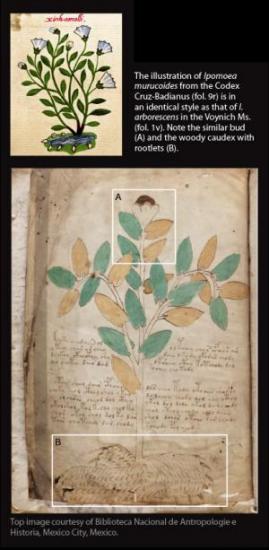Bob Yirka report
Source - http://phys.org/news/2014-02-botanists-voynich-similar-mexico.html

Credit: HerbalGram
A pair of botanists has published a paper in HerbalGram in which they note similarities between plant illustrations in the famed Voynich Manuscript and plant illustrations in old Mexican botanical books and suggest it might mean the Vonyich Manuscript has New World origins.
The Voynich Manuscript is a text (found in 1912 in an Italian monastery by book dealer Wilfred Voynich) believed to have been written in the 15th century (carbon dated to a time between 1404 and 1438) by an unknown author. It's attracted notice because it's written in a language that no one has ever been able to decipher despite over a century of trying. Making things even more interesting are illustrations throughout the manuscript that sometimes defy explanation—such as plants that no one has been able to identify. Some experts have suggested that the manuscript is a hoax, created by someone several centuries ago as a lark or ruse, for some unknown purpose. Others suggest the manuscript appears to be real in a sense as it does appear to follow some sort of grammar. In their paper, Arthur Tucker and Rexford Talbert suggest the key to solving the mystery might lie in the illustrations, rather than the text.
One section of the manuscript appears to be devoted to botany—words flow across pages decorated with illustrations of mysterious plants. Tucker and Talbert noticed that at least one of the plants in the manuscript reminded them of a plant they'd seen illustrated in an old Mexican botany book. Their interest piqued, they gathered as many such texts as they could find and set to work looking to see if they could match plants in the botany books with those in the Voynich Manuscript. In so doing, they say they have found 37 matches out of the 303 depicted. They also note some matches between six animals and at least one mineral.
The two botanists aren't suggesting their findings prove anything, instead they suggest that perhaps more work ought to be done investigating the possibility that the manuscript was written in old Mexico in an ancient Aztec language such as Nahuatl, which is still actually spoken in some remote parts of Mexico.
More information: A Preliminary Analysis of the Botany, Zoology, and Mineralogy of the Voynich Manuscript, HerbalGram, 2013: cms.herbalgram.org/herbalgram/issue100/hg100-feat-voynich.html